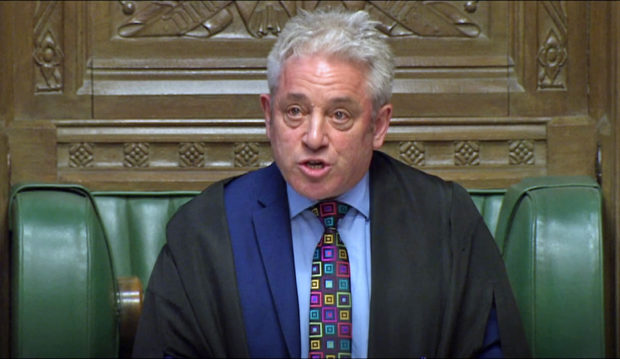House of Commons speaker John Bercow has warned another meaningful vote on Theresa May’s Brexit withdrawal deal may be blocked.
He says the Government can’t return to the House for another vote if the motion is substantially the same as last time.
His sensational intervention was made in a surprise statement to the Commons this afternoon.
Mr Bercow told the House of Commons: “If the Government wishes to bring forward a new proposition that is neither the same nor substantially the same as that disposed of by the House on March 12, this would be entirely in order.
“What the Government cannot legitimately do is resubmit to the House the same proposition – or substantially the same proposition – as that of last week, which was rejected by 149 votes.
“This ruling should not be regarded as my last word on the subject. It is simply meant to indicate the test which the Government must meet in order for me to rule that a third meaningful vote can legitimately be held in this parliamentary session.”
Devastating. The Government ‘can not’ bring forward another motion if is is substantially the same. Another meaningful vote probably gone.
— Pete Wishart (@PeteWishart) March 18, 2019
Mrs May plans to ask MPs to back her deal as the only realistic alternative after they strongly voted against the prospect of a No Deal Brexit last week.
However, the Prime Minister’s plans could now be in disarray unless she can convince the Speaker that MPs would be voting on a set of proposals that are substantially different to those which have already been rejected by heavy majorities.
Doing so would require the EU to accept significant changes to the withdrawal agreement — something negotiators in Europe have already shown they are unwilling to consider.
The Prime Minister’s official spokesman said: “The speaker did not warn us of the contents of the statement or indeed the fact that he was making one.”
SNP MP Pete Wishart tweeted: “Devastating. The Government ‘can not’ bring forward another motion if is is substantially the same. Another meaningful vote probably gone.”
Why has the speaker made this decision?
Mr Bercow said he was sparked into action by a question asked by Labour MP Angela Eagle last week, who wanted to know if the Government was allowed to keep bringing back the same motion again and again.
He said he consulted Erskine May, the Parliamentary procedural handbook, and found that a motion “which is the same in substance” may not be brought forward again “during that same session”.
The speaker said the convention dated back to April 2 1604 and said it had been confirmed again many times, including 1864, 1870, 1882, 1891 and 1912.
“Each time the speaker of the day ruled that a motion could not be brought back because it had already been decided in that same session of Parliament,” he continued.
“Indeed, Erskine May makes reference to no fewer than 12 such rulings up to the year 1920.
“One of the reasons the rule has lasted so long is that it is a necessary rule to ensure the sensible use of the House’s time and the proper respect for the decisions it takes.”



